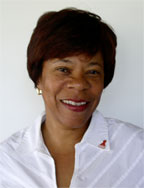Yes, we can! 
Dear Friend,
This New Year—marking our 20th anniversary of innovation and impact—promises to be a year filled with renewal, hope and growth.
For example, AIDS Research Alliance closed the door on our previous clinic in West Hollywood, and this year, we re-opened in a new, state-of-the-art research facility in downtown Los Angeles.
Likewise, our nation has closed the door on an Executive Branch that spent eight years attacking the integrity of scientific information.
Now, our country enjoys a President who values science and science-based efforts to advance HIV/AIDS prevention, care and research. We hope President Obama uses his first 100 days in office to re-envision a world without AIDS and to establish meaningful policies to achieve that goal.
We, too, have set priorities for our first 100 days in our new research facility.
- With the help of donors and friends like you, we will
equip a brand new research laboratory, which will significantly enhance
our ability to find a cure.
- We want to expand our education work to further mobilize those hardest hit by HIV/AIDS, especially in communities of color.
- We will acquire the rights to a breakthrough technology that will assure the availability of our intellectual property, prostratin, for in-human trials and eventually for the treatment of HIV.
All of these transformations—at the national level and within AIDS Research Alliance—will require us to roll up our sleeves and work. Together, we will heal our nation’s economy and reverse the course of HIV/AIDS epidemic. As always, you are the key to our success.
Brightest wishes for a prosperous, healthy and transformative 2009! 
Carolyn H. Carlburg, J.D.
President & CEO
Black Luv, Healthcare, & Cultural Mistrust
“It's clear that of all racial and ethnic groups in the U.S., HIV/AIDS have hit African Americans the hardest,” says Dr. Stephen J. Brown, ARA Medical Director.
To recognize National Black HIV/AIDS Awareness Day, we share some of the stories and some of the wisdom that lie behind these statistics.
Sweet-Tea Ethics: Black Luv, Healthcare, and Cultural Mistrust - Excerpt from Not in My Family: AIDS in the African-American Community by Edward M. Garnes Jr.,
Edited by Gil L. Robertson IV.
There once was a Persian cat who had a tail worthy of marvel. In arrogant displays, she would strut and fret many hours upon the stage... A flawed beauty, she often pranced around the railroad tracks behind old man Johnson's corner store. That was until karma came calling. In a tragic twist of fate, her tail was cut off in a freak accident.
An overzealous streetcar conductor ran over the Persian princess's tail as she attracted suitors one late southern evening. Ego crushed, and knocked from the pedestal she had carefully constructed, the former head-turner lamented her misstep. She lost her head over a little piece of tail.
"Never lose your head over a little piece of tail," snapped my southern-bred grandmother as she offered up her classic extended metaphor for sexual relations. From Samson to Kobe Bryant, many men have weathered the consequences of letting a little tail go to their heads. This fictitious "tail" narrative advanced by my late Grandma not only became classic family lore, but it also became the foundation of her "straight, no chaser" classes in sex education.
Before I hit puberty, and years before my incidences of puppy love morphed into incessant lust, my grandma had already schooled me on condom use and the prevalence of HIV/AIDS. And while many a relative chided her for being a little too frank with young folk, she was relentless with her unsanctioned safe sex lectures. You see, decades earlier, she had been the victim of misinformation. On one such occasion, after prodding my great granddad on the whereabouts of a missing playmate, she was informed that her best friend had broken her leg. In reality, the girl had become pregnant. So she made a vow to be as open and honest about "relations" to anyone in earshot. And boy, did she burn some ears.
As is the case for many black folks, my health education rarely came from PhDs or credentialed health professionals with carefully constructed marketing campaigns or brochures highlighting empty statistics. My education happened during Friday fish fries, Sunday dinners, and other random gatherings starring Grandma Lowe and a host of uncles, aunts, "play cousins," and family friends. Wrapped in love and peppered with stern warnings -- often emphasizing the consequences of unprotected sex -- these informal classes would form the core of my knowledge of reproductive health.
HIV/AIDS was given a personal face when a dear co-worker of my mother's, a deeply loving art enthusiast and cultural warrior who reminded me of literary giant James Baldwin, passed away. His death rocked my spirit, and his loss resounded louder to me than any PSA or clever catchphrase ever did. Most importantly, I watched how my mother and her collection of supporters rallied around their ailing friend, filling his last days with more food, laughter, and good times than he could stand.
Since its emergence, HIV/AIDS has always been viewed as an "other-people" affliction, as it was often associated with homosexuality, an orientation perceived by some to be a morally reprehensible lifestyle. As HIV/AIDS began to disproportionately affect the African-American community, theorists dusted off age-old notions of white supremacy couched in cultural pathology frameworks. Quite conveniently, these theories that associate immorality, free will, and inherent inferiority with African-American culture frequently become scapegoats for larger forces like poverty, persistent racism, and unchecked discrimination that inhibit life chances and deeply affect quality of life.
Health care is often an impersonal affair regularly divorced from an African-centered worldview, but delivery of health-care services absent social context misses the mark. Therefore, it is imperative that health professionals understand black construction of social reality. In their groundbreaking work The Psychology of Blacks: An African- American Perspective, Dr. Joseph White and Dr. Thomas Parham clearly delineate the five major characteristics that define African-American psychology: improvisation, resilience, connectedness to others, the value of direct experience, and spirituality.
|
Our First 100 Days Your gift of $25 will help us hit our goal of $350,000 needed to purchase equipment for our new science laboratory.
Your support. Our Research.
|
BREAKING NEWS FROM |
Hope for HIV Prevention Method Unveiled
An experimental vaginal gel has shown some promise in preventing HIV infection — the first study to offer hope that a microbicide may soon join the medical arsenal in the fight against HIV, scientists announced Monday.
The results aren't conclusive in this preliminary study, but they were welcome news considering the failure of other similar products. The multi-country study suggests the gel cut HIV infection by 30%.
Scientists have been trying to develop gels and other microbicides for women (or men) to use as protection in parts of the world where their partners may refuse to use condoms.
“This is the first study that shows there is a promising candidate,” observed Dr. Marjan Hazerah, Scientific Director of ARA, who is reporting from the 16th Conference on Retroviruses and Opportunistic Infections in Montreal, where the findings where released. “The results offer hope for women… and this ‘proof of concept’ should also invigorate the field."
This large study of over 3100 women was designed mainly to test whether the gel was safe. The women were divided into four groups. One quarter received PRO2000, a gel made by Indevus Pharmaceuticals, which is supposed to block the AIDS virus from attaching to certain white blood cells. Another quarter were put on a gel made by Baltimore-based ReProtect. The rest were given a placebo gel, or no gel at all.
All the women were counseled to have their partners use condoms. The study was done in South Africa, Malawi, Zambia, Zimbabwe and the United States, and was funded by the U.S. National Institutes of Health.
Researchers found that women who used the PRO2000 gel had a 30 percent lower rate of HIV infection than the other women who received a placebo gel. But the difference was not statistically significant, meaning the results could have occurred by chance. However, the study also found that the women who reported using PRO2000 the most, had the greatest reduction in infections demonstrating a possible dose-response effect.
Health officials say larger studies are needed to better assess effectiveness. Such a study of the Indevus gel, involving 9,400 African women, is to conclude in August.
http://www.aidsmap.com/en/news/6EB96FD6-425A-4F22-8083-1233C649664D.asp
The Centers for Disease Control and Prevention (CDC) issued statistics that should be a clamoring wake up call.
Looking at HIV/AIDS by race/ ethnicity, we see:
- African Americans have more HIV infections. Even though blacks account for about 13% of the U.S. population, they account for 49% of people getting HIV and AIDS. Black women are at least 15 times more likely to get infected with HIV than white women.
- African Americans have shorter survival times. Blacks with AIDS often don’t live as long as people of other races and ethnic groups with AIDS.
- African Americans have higher death rates. For African Americans and other blacks, HIV/AIDS is a leading cause of death.
|
A Clamoring Wake-Up
The Centers for Disease Control and Prevention has issued disturbing statistics
looking at HIV/AIDS by race/
ethnicity, we see:
- African Americans have more HIV
infections. Blacks only account for about 13% of the U.S.
population, but account for 49% of those who get HIV
and AIDS. Black women are 15 times more likely than white women to get infected.
- African Americans have shorter survival times. Blacks with AIDS
often don’t live as long as people of other races and ethnic groups
with AIDS.
- African Americans die of AIDS more often. For African Americans and other blacks, HIV/AIDS is a leading cause of death.
|
Get Involved in Research
on Lubricants and Sex
Click to read about this, or any of our currently enrolling studies. |
|
ARA is Now Hiring
|
|





